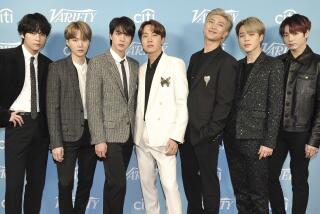Singular vision of Monocle’s founder
The death of print is often lamented among media types these days, in the era of Google ads and the mad exodus of advertisers from dreary old ink-on-paper. But Tyler Brûlé doesn’t buy it.
The London-based founder and editor of Wallpaper*, the definitive late-1990s design-travel-shelter-entertaining-lifestyle magazine, stopped over in Los Angeles on his way to Silicon Valley recently to barnstorm upscale advertising targets -- Apple, Lexus -- for his new publication, Monocle, which is targeted at the borderless global elite. Brûlé has mixed views on the city. “L.A. is full of extremes for me,” he said. “I love the Modernist architecture but loathe the strip malls. And I want to see more neighborhoods where people walk and bike and get out of their cars.”
A vintage Brûlé comment, and one that neatly summarizes his attitude about a life lived well and his ambitions for his latest magazine. Monocle, which has been available since early this year, strives to combine Brûlé’s indefatigable cosmopolitanism with his desire to improve the world, one devoted reader at a time. In a media world where words are a vanishing species, Monocle practically wallows in its allegiance to a theoretically outmoded publication model: uncoated paper stock, precisely set columns of type and a smooth mix of photography, illustration and info-graphics. There’s also a website, monocle.com, but it’s thus far a rudimentary exercise. The not inexpensive print version -- $10 a pop in the U.S., published 10 times a year -- is clearly where his 38-year-old heart lies. In fact, Monocle is a dense, multilayered allusion to the heyday of a certain kind of serious printed enterprise.
Most new magazines these days do not boldly describe themselves, as Monocle does, as “a briefing on global affairs, business, culture and design.” Nor do they take an avowed anti-celebrity stance (a “house rule,” according to Brûlé). If Monocle’s hybrid of the old-school news weekly and the Japanese “magalog,” of which Condé Nast’s Lucky is the best known version, can succeed, then there will be a strong indication that a serious youth audience for print continues to exist.
Brûlé is optimistic. “I have a personal passion for news and foreign affairs,” he said, munching on breakfast bacon at the Four Seasons in Beverly Hills. “I’m not obsessed with looking at someone’s constantly updated blog.” With his neat beard, Rolex and olive-drab blazer, he still looks the part of the foreign correspondent he once was.
Remember Time? Remember Newsweek? No, not in their current, etiolated incarnations, but in their 1970s glory, when the far-ranging weekly news digest strode large upon the media landscape. That generation of American glossies is just the tip of Brûlé’s iceberg. His fetishistic inspiration for Monocle is the hard-core news weekly of his European youth, magazines like Germany’s Der Spiegel and Stern, deftly covering culture, strife and political malfeasance with depth, insight and -- not incidentally -- great photography. Brûlé’s model for Monocle embraces provocative, unapologetically self-important magazine-making, the sort of thing that has now migrated to the Economist and the New York Review of Books.
In many respects, Brûlé, who is gay and in a long-term relationship but seemingly indifferent to sexual politics, is the perfect Gen X media entrepreneur. Monocle, with its features on the “Top 20 Liveable Cities,” stories on startup running-shoe companies, artfully composed fashion spreads and concluding manga comic, combines Brûlé’s romantic view of journalism with an eminently futuristic vision of how the post-boomer cadre wants to live.
Like his fellow Canadian-born magazine impresario, Vanity Fair’s Graydon Carter, Brûlé has managed to create -- twice now -- something of absorbing visual elegance that’s also worth reading.
Of course, with Monocle, one also gets Brûlé’s other passion: shopping. Readers of the New York Times “T” Style magazines will be familiar with this side of his personality, as over the years he has contributed globe-trotting speculations on how to obtain the perfect luggage and the most versatile sportswear. Stuff has always been on his mind: He runs a design firm in addition to developing magazines. After Wallpaper* was bought by Time Warner and Brûlé eventually departed, he revamped the Swiss national airline’s visual identity. In fact, a preoccupation with a level of design esoterica accessible mainly to the international jet set of the Clinton administration was a consistent knock against Wallpaper*. The stimulating lifestyle proposed by the magazine came with an entry fee that far exceeded the cover price and implied a fairly lofty tax bracket.
This may be the battle that defines Brûlé’s editorial soul, but he can always dodge assaults on his cred by showcasing the war wounds: the actual war wounds, sustained during an ambush, when he was a young, college-dropout freelancer (for, naturally, a German news weekly) in Afghanistan, hitching a ride with Doctors Without Borders. One bullet destroyed nerves in his left arm, robbing him of the use of his hand. The other round chewed into his right forearm, leaving a nasty reminder whenever he rolls up his sleeves.
In fact, Brûlé credits his convalescence period with giving him the time he needed to dream up Wallpaper*. “I felt sorry for myself,” he said. “But the doctor said I should learn to cook to help regain some ability with my hand, and I had just moved into an ugly house in England that needed to be decorated. In 1996 there was a reurbanization going on. It was cool to live in the city. Being in the suburbs and having a big house was not what it was all about.” According to Brûlé, he packaged this new urbanist sensibility with travel and entertaining and -- presto! -- Wallpaper* was born.
It did not take long for the magazine to achieve escape velocity, in media terms, nor for Brûlé to sell the fledging publication in 1997 to giant Time Warner, where it is still being produced (although the aftermath of 9/11 and the ascent of more ecologically oriented shelter books such as Dwell have undermined some of its original editorial philosophy). He stayed on the masthead for another four years and then departed to focus on his design work.
“I left Time Warner after signing a long non-compete agreement,” he said, explaining why he worked primarily as a branding consultant and newspaper columnist, for outlets such as the Financial Times, before the Monocle launch.
The September issue, No. 6, is fat with luxury advertisers. Brûlé’s introductory brief on nation-branding -- “If brand is everything then the concept of place branding is still virgin territory” -- is preceded by lush pitches from Ralph Lauren, Louis Vuitton, Gucci, Versace, Prada, Hugo Boss and Tod’s. What follows, however, is the furthest thing from fluff. There is page after page of dense yet enticing text, laced with savvy argument and writerly panache. By and large, the writers are not big names but rather versatile journalists who can get the job done.
You can say one thing about Monocle: It’s no flip-through. This is a magazine that intends to occupy coffee tables for months, then be passed along to spend time on other people’s coffee tables, before being stored in acid-free archival boxes. This is National Geographic territory, and don’t chuckle, because that hoary bastion of photojournalism is another of Brûlé’s inspirations.
Brûlé has so much faith in Monocle’s prospects that he and his partners -- including a quintet of wealthy international families putting up some of the funds -- have decided to induce subscribers to foot a radically larger chunk of the bill than they are accustomed to. “You can’t leave it all up to the advertisers,” he said. “And the discount subscription model is wrong.” The result, for a magazine that would cost $100 to buy yearly at the newsstand? A $150 subscription, which includes access to Monocle’s online archive. (He says that Monocle currently has 4,000 subscribers.)
“I’ve always sought the mortar to bind my divergent interest together,” he said. “With Monocle, I decided we needed something more bookish. Yeah, there’s a lot to read in the magazine. But that’s the idea.”
More to Read
Sign up for our Book Club newsletter
Get the latest news, events and more from the Los Angeles Times Book Club, and help us get L.A. reading and talking.
You may occasionally receive promotional content from the Los Angeles Times.






